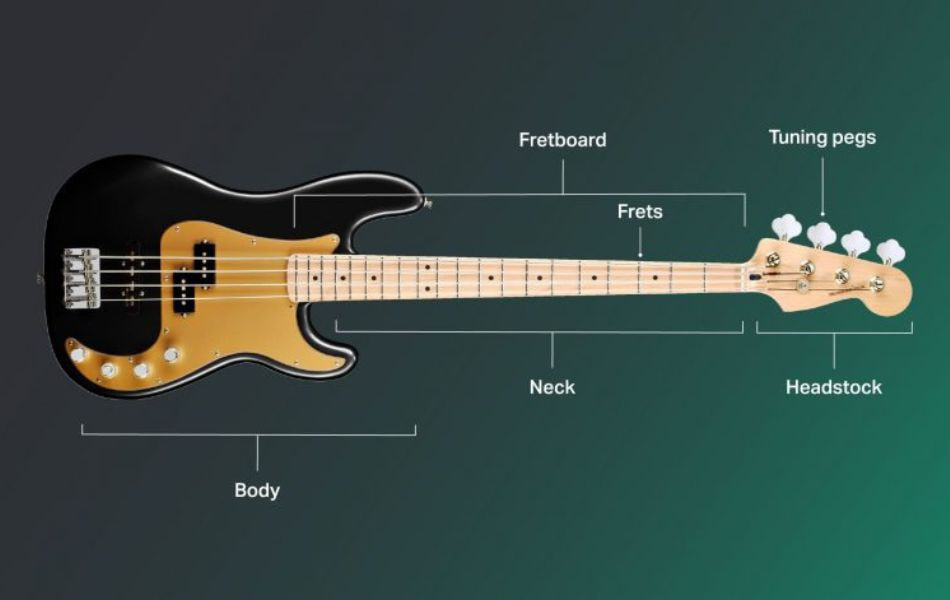Over the next 5 days, we will explore and learn the basic but most important skills to start playing bass guitar. Here, you will be guided from the first steps of basic grip to how to play basic rhythms. Explore detailed bass guitar lessons for beginners.
Contents
Day 1: Getting to Know Your Instrument
Knowing the parts of the instrument will come in handy, especially when buying your very first beginner guitar. Get familiar with at least the following guitar parts:
Body
This is the largest part of the guitar that you hold against your own body. In an acoustic guitar, the body is hollow to amplify the sound, whereas an electric guitar has a solid body.
Neck
The guitar’s neck is the long part protruding from the body. Right-handed players hold the neck with their left hand, which is also known as their fretting hand. Left-handed players can choose to play the same way, flip a regular guitar the other way, or look for a left-handed guitar.

Headstock and Tuning Pegs
At the end of the guitar’s neck, you find the headstock. This is where the instrument’s tuning pegs are attached. Tuning pegs are used for tuning the guitar.
Fretboard and Frets
The fretboard runs along the neck of the guitar and has small frets that help navigate the fretboard when playing. When playing the guitar, you press the strings against the fretboard. There are also fretless guitars, although those aren’t recommended for beginners who are still learning to play.
Proper Posture and Hand Positioning
Sitting Position: Sit up straight in a comfortable chair. Rest the guitar on your right thigh (for right-handed players) or left thigh (for left-handed players). Use a footstool if necessary to raise the leg and stabilize the guitar.
Standing Position: Use a strap to hold the guitar securely. Adjust the strap so the guitar is at a comfortable height, typically around your waist or slightly higher.
Day 2: Tuning bass guitar
One of the most important things for beginner bass guitar lessons is tuning. There are various tuning styles for bass guitars, but the most common one is standard tuning. In addition, alternative tunings are also used for tuning.
However, other tuning styles are also used depending on the musical requirements and playing styles of individuals. Below are some commonly used tuning styles:
Standard Tuning:
- 4-String Bass: E, A, D, G
- 5-String Bass: B, E, A, D, G
- 6-String Bass: B, E, A, D, G, C
Usage: Standard tuning is the most widely used because it suits most music genres and helps players easily follow the notes on the fretboard.
Alternative tuning
- Half-Step down tuning
- Drop D tuning
- DADGAD tuning
There are many ways to tune bass guitars such as tuning by ear, tuning applications, clip tuners… We introduce to you guitar tuning – Guitar Tunio, a tuning application that integrates many extremely great features and is suitable for everyone, especially beginners.
Day 3: Bass finger techniques
You have 2 options: play with pick or finger. In fingerstyle, you use your fingers directly to play the strings without using a pick. This is a popular style and allows you to have more control over the sound and flexibility of your bass playing.
Thumb: Usually used to play the E, A and D strings, which have a deeper sound. The thumb usually plays the string from the bottom up to create a rich and powerful sound.
Index Finger, Middle Finger and Ring Finger: Usually used to play the G, B and higher strings. You can use these fingers to play the strings more gently and flexibly than your thumb.
whereas, in pickstyle, you use a pick to play the strings instead of using your fingers directly. This style often produces a sharp sound and provides a different feel than fingerstyle. Pick is held by the thumb and index finger or just the thumb. You play the strings by touching the pick to the strings and pulling them up or down depending on your musical needs.
Day 4: Bass notes and fretboard
Knowing the positions of the notes on each string helps you produce accurate sounds without having to look down at the fretboard. This is an important bass guitar lesson for beginners. This allows you to focus more on playing and interacting with your band. Once you’re familiar with the positions of the notes on the fretboard, transitioning between notes and playing different groove patterns becomes quicker and more efficient. This enables you to play music more flexibly and effortlessly.

Day 5: Chord bass guitar lessons
Starting with simple and easy chords is a good way to build a basic foundation in playing bass guitar. Here are some popular chord types that are suitable for beginners:
- Major Chord
- Major Chord
- Root-Fifth Chord
From mastering the basics of grip to navigating through basic rhythms, each day will bring new insights and techniques to elevate your playing. Dive into detailed beginner bass guitar lessons, and let your musical journey begin!
